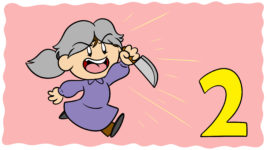Creating a worthy antagonist is just as important to an unput-downable story as the heroic protagonist.
I know it’s easy, even as a writer, to fall victim to the charms of your protagonist and focus most of your attention on him or her. But imagine Sherlock Holmes without Moriarty, Mowgli without Shere Khan. These antagonists are as imperative to their respective stories as the main character. They are the challenge to be overcome, the catalyst that sets off the protagonist’s action.
To really give your story justice and your protagonist’s achievements real value, creating a strong opponent is essential.
Let’s have a look at how this can be accomplished.
1. Give your antagonist a past
You will probably spend hours researching and thinking about the character traits and history of your protagonist to really give “him” dimension. After all, the protagonist is who drives the story and his creation is most likely what inspired the story to start with. But it is just as important to give as much time and devotion to the antagonist.
Think of it psychologically: there’s a reason why we all behave in certain ways, why we judge a situation or react differently to how others might. Our histories give shape to who we are. Thus, if you are aiming to create a respectable, three dimensional antagonist, he or she should have a solid history that motivates that bad or opposing behavior.
You will find many variations of the motivation that might drive an antagonist—greed, anger, ignorance, insanity, prejudice, fear, heartbreak, honor, even excessive goodness that is piously counteractive.
Finding example back stories that would inspire any one of these wouldn’t be too difficult and I “shan’t sport with your intelligence” or time by expounding on these. But I would say, make the back story plausible. The Goldfingers and Dr Evils of this world are all very well in their place, but if you’re aiming to write a serious, believable plot, make that back story compelling and make it possible.
A useful tool: I recommend spending some time looking at the story from the antagonist’s point of view, almost as if you were to write the story with the positions reversed. By doing this you would need to give time and thought to creating effective and believable characteristics for your antagonist and a deliciously juicy history that made him the person that is worthy of opposing your hero. You will also find you discover new traits about your antagonist that you had not previously thought of, or a hole in their arc that would need filling.
2. What if your antagonist doesn’t actually know they’re the antagonist?
Journalism 1-0-1: objectivity. Present both sides of the story.
Okay, so this is slightly tricky when you have created the story from a certain perspective, with a particular character in the position of The Hero. But pretend for a moment you, a neutral observer, are reporting on an epic battle between opposing sides and, being the world-class, unbiased journalist, you would be interviewing both parties.
In doing this, you will notice something interesting—the hero doesn’t know he is the hero and the bad guy doesn’t know he is the bad guy. More intriguing still, your antagonist actually thinks he’s the protagonist.
Both sides believe their cause is the just one and both act with conviction, so write both sides with conviction.
Present the antagonist’s story from his point of view and don’t distort or weaken it in favor of the hero. That is the easy way out. If the antagonist’s story and his defence of it are strong, then the protagonist’s success in defeating him is all the more glorious.
3. “Antagonist” doesn’t necessarily mean “bad guy”
There is this idea that “antagonist” automatically means “bad guy”. It doesn’t. The Oxford English Dictionary defines it thus:
One who contends with another in an athletic contest, a battle, or struggle for the mastery; an opponent, an adversary.
Nowhere do you see “bad”, “evil”, “bald and cat-loving”.
Therefore it is quite acceptable to have a likeable antagonist. You might even create sympathy for him by means of an emotional back story, forced into a situation which makes him react in a way he wouldn’t normally. Or perhaps he is someone who makes the wrong decisions, but is not intentionally unkind.
If you look at Willoughby in Sense and Sensibility, he does love Marianne, but his situation and his poor choices drive him to hurt her.
To turn the notion completely on its head, the “antagonist” doesn’t have to mean the “bad” in the situation at all. You may well be writing the story from the point of view of the bad guy, that is, your protagonist is the bad egg in the plot, the criminal on the run, and his antagonist a detective of moral and honor. This would certainly make for an interesting read and test the loyalties of your readers.
Sympathizing with the antagonist makes the story more interesting and—brace yourself—it will make readers really think about the message you are trying to deliver.
4. Don’t let the antagonist overshadow the protagonist
However you decide to cast your antagonist—the respectable character in the story, likeable in a good way, like the detective, or a character so gloriously evil, with such brilliant one-liners, that the reader looks forward to each encounter with him—don’t fall out of love with your protagonist.
Make sure your antagonist is not so colorful that he makes the protagonist look gray. The protagonist is the main event—don’t let him or her be overshadowed.
Of course, I would encourage flexibility. If, as you are writing, you discover that actually the antagonist is the more interesting character, think about reversing the roles and writing from a different perspective, if you feel your message can still be effectively delivered.
5. Keep the readers guessing
Here’s a question: why make it obvious who the antagonist is? As the writer, you will have created that back story and will be able to weave it in subtly, so when the time comes for the antagonist to be revealed, the reader will be able to look back with satisfaction at the clues that are now so clear.
Wouldn’t it be more interesting and alluring to the reader if it is not quite clear who is on who’s side? You might even create a Professor Snape type diversion—a character who has the appearance of an antagonist, but actually…
The underlying message is make sure you give your hero a worthy opponent and make the “fight” interesting—world championship boxing ring standard, not a petty school ground punch-up.






2 thoughts on “Here’s How To Give Your Antagonist A Little Oomph”
Again, I find these articles a real treasure. Watch out for the “Snape” spoiler! 😉
Great stuff I’m going to apply this to my wip. ^-^